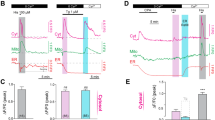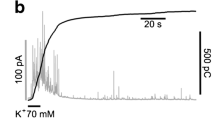Abstract.
The polyamine secretagogue, aminoethyldextran (AED), causes a cortical [Ca2+] transient in Paramecium cells, as analyzed by fluorochrome imaging. Our most essential findings are: (i) Cortical Ca2+ signals also occur when AED is applied in presence of the fast Ca2+ chelator, BAPTA. (ii) Extracellular La3+ application causes within seconds a rapid, reversible fluorescence signal whose reversibility can be attributed to a physiological [Ca2+] i transient (while injected La3+ causes a sustained fluorescence signal). (iii) Simply increasing [Ca2+] o causes a similar rapid, short-lived [Ca2+] i transient. All these phenomena, (i–iii), are compatible with activation of an extracellular ``Ca2+/(polyvalent cation)-sensing receptor'' known from some higher eukaryotic systems, where this sensor (responding to Ca2+, La3+ and some multiply charged cations) is linked to cortical calcium stores which, thus, are activated. In Paramecium, such subplasmalemmal stores (``alveolar sacs'') are physically linked to the cell membrane and they can also be activated by the Ca2+ releasing agent, 4-chloro-m-cresol, just like in Sarcoplasmic Reticulum. Since this drug causes a cortical Ca2+ signal also in absence of Ca2+ o we largely exclude a ``Ca2+-induced Ca2+ release'' (CICR) mechanism. Our finding of increased cortical Ca2+ signals after store depletion and re-addition of extracellular Ca2+ can be explained by a ``store-operated Ca2+ influx'' (SOC), i.e., a Ca2+ influx superimposing store activation. AED stimulation in presence of Mn2+ o causes fluorescence quenching in Fura-2 loaded cells, indicating involvement of unspecific cation channels. Such channels, known to occur in Paramecium, share some general characteristics of SOC-type Ca2+ influx channels. In conclusion, we assume the following sequence of events during AED stimulated exocytosis: (i) activation of an extracellular Ca2+/polyamine-sensing receptor, (ii) release of Ca2+ from subplasmalemmal stores, (iii) and Ca2+ influx via unspecific cation channels. All three steps are required to produce a steep cortical [Ca2+] signal increase to a level required for full exocytosis activation. In addition, we show formation of [Ca2+] microdomains (≤0.5 μm, ≤33 msec) upon stimulation.
Similar content being viewed by others
Author information
Authors and Affiliations
Additional information
Received: 30 August 1999/Revised: 1 December 1999
Rights and permissions
About this article
Cite this article
Klauke, N., Blanchard, MP. & Plattner, H. Polyamine Triggering of Exocytosis in Paramecium Involves an Extracellular Ca2+/(Polyvalent Cation)-Sensing Receptor, Subplasmalemmal Ca-Store Mobilization and Store-Operated Ca2+-Influx via Unspecific Cation Channels. J. Membrane Biol. 174, 141–156 (2000). https://doi.org/10.1007/s002320001039
Issue Date:
DOI: https://doi.org/10.1007/s002320001039




